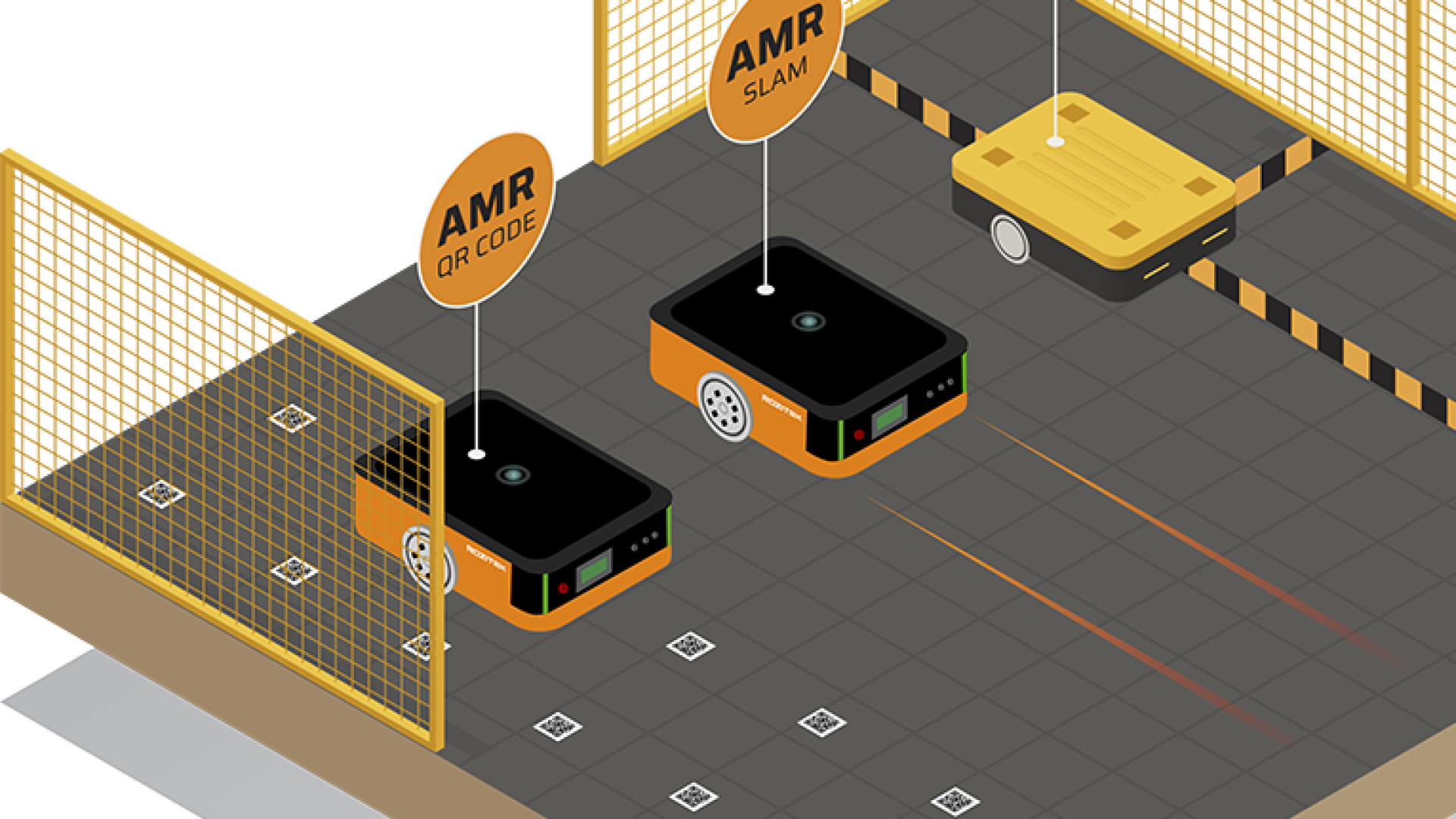Automated Guided Vehicles (AGVs) and Autonomous Mobile Robots (AMRs) have become major talking points in Australian warehouses and distribution centres, where operators are chasing better efficiency and reduced costs. Both technologies promise to ease the burden of repetitive transport tasks, but they differ significantly in how they navigate, adapt and fit into a busy supply chain.
Selecting the wrong system can lead to a raft of inefficiencies down the line. This article breaks down the essential differences between AGVs and AMRs, exploring what sets them apart in navigation, cost and scalability. By inspecting the nuances of each solution, warehouse managers and logistics professionals can decide which approach best suits their operational goals and long-term growth plans.
What are AGVs?
Definition and functionality
AGVs are Automated Guided Vehicles that follow fixed pathways using predefined infrastructure. Typically, these vehicles rely on magnetic strips, QR codes, or sensor-based markers to guide them along a set route. Their straightforward navigation suits industrial mezzanine floors or plants where tasks remain stable over time. In many facilities, AGVs shuttle pallets or components between production lines, staging areas, or dispatch points, removing the need for staff to manage repetitive hauling tasks manually.
Because AGVs stick to programmed routes, they excel in predictable environments. Their sensors and basic controllers are usually tuned to a single route at a time, ensuring reliable, no-fuss operations (provided conditions don’t change dramatically).
Advantages of AGVs
AGVs can be a top-notch pick for processes that rarely shift in layout or volume. Because they travel on fixed tracks, they deliver strong repeatability, which resonates well in many manufacturing contexts where stability is valued. They also tend to cost less than fully autonomous solutions, which is handy for budget-conscious sites that still want to reduce labour-intensive tasks.
Once these vehicles are installed, staff training requirements remain relatively modest. Operators learn the routes, supervisors plan schedules and AGVs repetitively perform the same movements without the fuss of route updates. In structured supply chains, that reliability translates to fewer unexpected stops and a more transparent workflow from start to finish.
Limitations of AGVs
AGVs lose some of their charm when change becomes the norm. Any redesign of the warehouse, or sudden shift in production flow, might mean relaying magnetic strips or moving floor markers. That downtime can throw a spanner in the works for companies striving to remain agile in today’s market. AGVs also lack advanced on-board intelligence, so they can’t spontaneously dodge obstacles or map out alternate pathways.
In dynamic environments, like e-commerce fulfilment centres under constant reorganisation, AGVs might struggle to keep up. Even minor hitches can halt operations if an obstacle blocks the track, leaving an AGV stuck until a worker intervenes. This rigidity makes them less appealing when real-time adaptability is paramount.
What are AMRs?
Definition and functionality
AMRs, or Autonomous Mobile Robots, bring a whole new level of intelligence to industrial automation. Rather than relying on pre-laid guides, they use on-board sensors, cameras and AI-driven software to navigate. Many AMRs employ simultaneous localisation and mapping (SLAM), creating real-time maps to detect obstacles and plan routes. This frees them to traverse shifting layouts and spontaneously work around unexpected barriers.
AMRs often feature in modern warehouses where product lines change frequently, or where multiple picking stations must be rearranged as demand ebbs and flows. Their real-time adaptability is especially handy for operations wanting immediate route adjustments.
Advantages of AMRs
AMRs thrive on flexibility. They don’t require floor tracks or fixed beacons, letting facilities reconfigure racks and aisles without incurring the significant costs of re-laying guidance infrastructure. Over time, an AMR fleet can use data analytics to fine-tune travel paths, avoid congestion, and trim time spent on redundant journeys.
Because AMRs operate with advanced autonomy, they typically mesh well with integrated warehouse automation projects. By sharing data with a Warehouse Management System (WMS), they prioritise deliveries or restock lines dynamically. This synergy helps businesses stay competitive and respond rapidly to shifts in consumer demand or supply chain disruptions.
Limitations of AMRs
Naturally, AMRs don’t come cheap. Their on-board sensors, AI software and integration needs mean a heftier upfront price tag than simpler AGVs. Ongoing software maintenance is another consideration, and staff training could be more involved if operators must learn how to manage a network of self-directed bots.
Strong network connectivity is often a must, given that AMRs communicate with central controllers, WMS, or cloud-based analytics services. A patchy wireless setup can stifle their potential. While they are arguably more advanced, they also carry that added layer of technical complexity which might require support from skilled technicians or robotics specialists.
Key differences between AGVs and AMRs
Navigation technology
-
AGVs rely on physical markers, such as magnetic strips or sensors, to remain on predetermined routes.
-
AMRs use AI-powered perception, scanning their surroundings to generate routes in real time.
Flexibility and adaptability
-
AGVs function smoothly in facilities with stable layouts.
-
AMRs shine in dynamic spaces, adapting routes independently without large-scale reconfiguration.
Scalability for growing warehouses
-
AGVs demand additional tracks or markers if the facility expands.
-
AMRs simply join the existing fleet, where each robot maps new areas with minimal fuss.
Integration with warehouse systems
-
AGVs might require only basic coordination, ideal for simpler workflows.
-
AMRs often integrate deeply with WMS or AI-driven coordination, enabling real-time task assignments and route optimisations.
How to choose between AGVs and AMRs
When debating AGV vs. AMR comparatively, start by reviewing:
-
Warehouse layout and infrastructure: If your site sees few layout changes, AGVs may suffice. For unpredictable environments, AMRs typically offer greater long-term value.
-
Scalability needs: AGVs work well in stable, high-volume production lines. Meanwhile, AMRs handle expansions with ease, especially in fast-growing or multi-channel operations.
-
Cost factors: While AGVs can cost less initially, modifications over time add up. AMRs involve higher initial outlay but can reduce overheads in facilities that are frequently revamped.
-
Operational goals: For a purely structured transport system with minimal route changes, AGVs tick all the boxes. Those prioritising real-time adaptability might find AMRs a better fit.
-
Integration requirements: If you rely on advanced analytics or real-time coordination, AMRs integrate neatly. However, if your workflow is straightforward, AGVs might keep life simpler.
Industry applications and use cases
-
E-commerce and retail distribution: AMRs excel at responding to shifting pick zones and fast-changing stock locations.
-
Manufacturing and assembly lines: AGVs transport components or finished goods in stable, repetitive loops.
-
Healthcare and pharmaceutical warehousing: AMRs deliver precision in unpredictable storage requirements and frequent reorganisation.
-
Automotive and heavy industry: AGVs handle set processes in standardised production lines, where layouts are tightly controlled.
Conclusion
Selecting between Automated Guided Vehicles (AGVs) and Autonomous Mobile Robots (AMRs) is a crucial decision for any warehouse or facility eyeing more efficient material handling robots. In short, it’s a balancing act—if you’re chasing predictable throughput on a fixed floor plan, AGVs fit the bill. But if growth, variety, and on-the-fly changes are on the cards, AMRs could be the wiser bet.
Whether you’re planning on building a new mezzanine system for an AGV or AMR warehouse or looking to upgrade an existing one, our team at Unistor has the expertise and the commitment to deliver the best solutions. Talk to us today about tailoring a mezzanine solution that aligns with your business goals.



